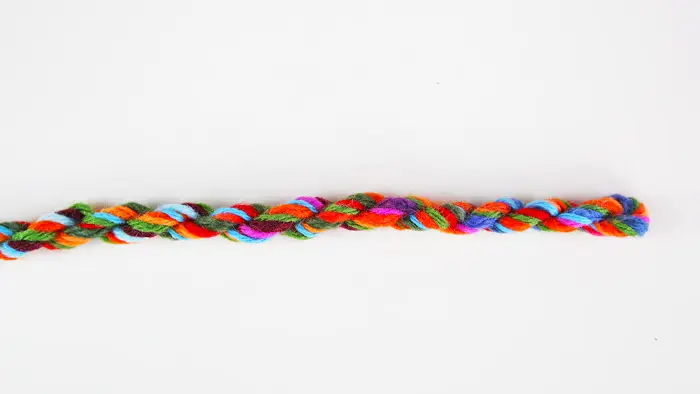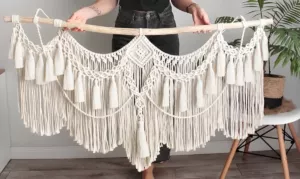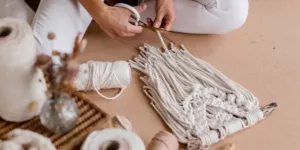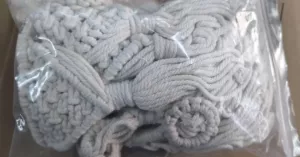Can You Make Rope from Wool Yarn – Wool yarn, a staple of the textile industry, is renowned for its remarkable properties that stem from the inherent characteristics of wool fibers. Sourced primarily from sheep, wool yarn can vary significantly in texture, strength, and flexibility based on the breed of sheep, the climate they live in, and the specific part of the fleece used. This section delves into the unique attributes of wool yarn and contrasts it with more traditional rope materials such as hemp, sisal, and nylon.
Properties of Wool Yarn
- Flexibility: Wool fibers are naturally crimped, which means they have a wavy structure. This crimping grants wool yarn superior flexibility, enabling it to be woven or twisted into various textures and strengths. The elasticity of wool fibers also contributes to this flexibility, allowing wool yarn to stretch under tension and return to its original shape, a property invaluable in textiles and potentially in rope making.
- Strength: While not as inherently strong as some synthetic fibers, wool yarn can possess considerable tensile strength, especially when spun tightly or plied together. The strength of wool yarn is also dynamic; it increases when wet, allowing for versatile applications in different environments.
- Fiber Characteristics: Wool fibers boast a natural coating of lanolin, which provides a degree of water resistance. This unique feature, coupled with wool’s ability to absorb moisture without feeling wet, makes wool yarn an intriguing option for ropes intended for use in damp conditions. Furthermore, wool is naturally flame-resistant, adding a layer of safety in scenarios where synthetic fibers might pose a risk.
Wool Versus Traditional Rope Materials
- Hemp: Historically favored for rope due to its high strength and durability, hemp offers a robust option for heavy-duty applications. While wool may not match hemp in terms of raw strength, wool’s superior elasticity and comfort make it better suited for applications requiring flexibility and gentleness, such as in handicrafts or lightweight securing tasks.
- Sisal: Another plant-based rope material, sisal, is valued for its biodegradability and toughness. Sisal ropes are often stiff and can be abrasive, contrasting sharply with wool’s softness and pliability. For tasks that demand a softer touch or where user comfort is a priority, wool yarn ropes offer a distinct advantage.
- Nylon: A synthetic powerhouse, nylon boasts exceptional strength, abrasion resistance, and endurance under weather elements. However, its production is energy-intensive and less eco-friendly. Wool, being a natural and renewable resource, represents a more sustainable choice, with the added benefit of biodegradability and lower environmental impact over its lifecycle. While wool might not compete with nylon’s sheer strength and durability, it carves out its niche in applications where sustainability, comfort, and specific insulation properties are valued.
Benefits of Using Wool Yarn for Rope
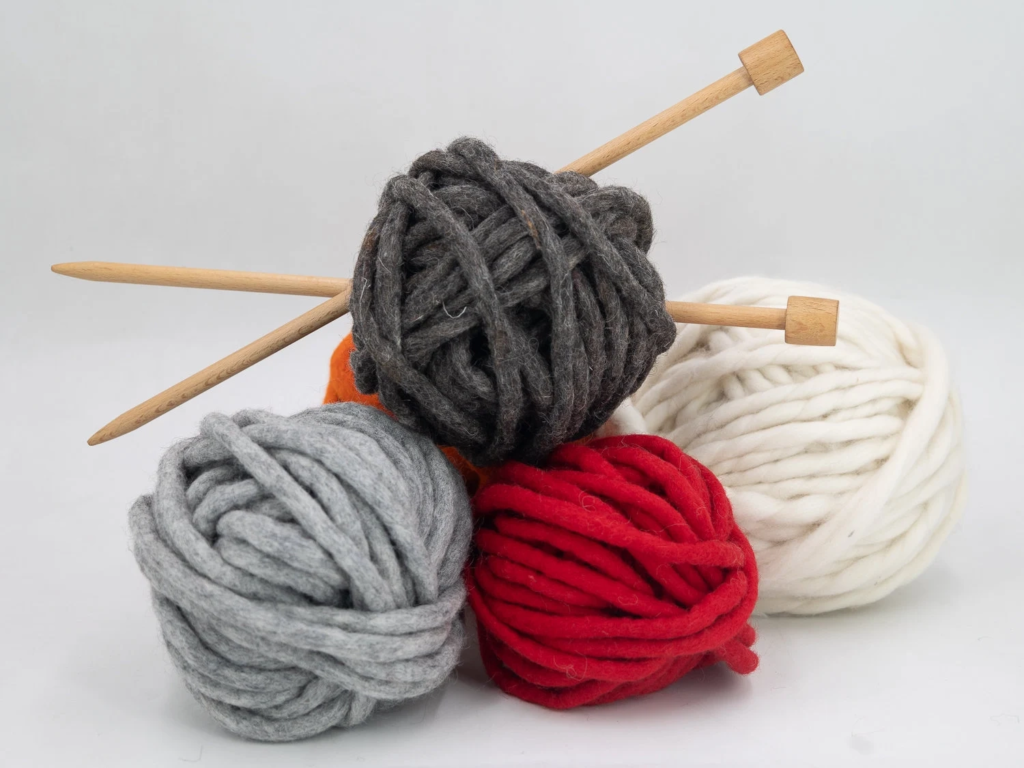
In the realm of rope-making, alternates to traditional materials like hemp, sisal, or synthetic fibers are continually being explored. Wool yarn emerges as an intriguing option, not merely for its aesthetic appeal but also for the variety of benefits it offers, ranging from its environmental impact to its unique physical properties. Here’s a look at some of the inherent advantages of using wool yarn for crafting ropes.
Environmental Impact: Sustainability of Wool
Wool distinguishes itself as a highly sustainable choice compared to synthetic fibers used in rope making. Derived from sheep, it is a natural and renewable resource, with sheep producing a new fleece each year, making wool an endlessly replenishable material. This contrasts sharply with synthetic ropes made from petroleum-based products, which contribute significantly to ecological degradation through their manufacturing process and long-term environmental footprint.
- Biodegradability: Wool is inherently biodegradable. At the end of its life, wool rope can decompose, adding nutrients back into the soil, unlike synthetic ropes that may take hundreds of years to break down, often releasing harmful microplastics into the environment during their decomposition.
- Energy Consumption: The production of wool is generally less energy-intensive compared to the manufacturing of synthetic fibers, which requires significant amounts of fossil fuels. By choosing wool, the rope-manufacturing process leans towards a smaller carbon footprint.
Softness and Flexibility: Advantages of Wool Ropes
One of the primary benefits of using wool yarn for rope is its inherent softness and pliability. These qualities make wool ropes particularly suitable for applications where a gentle touch is needed.
- Crafts and Decor: Wool ropes can be an excellent choice for domestic crafts, artisanal decorations, or any application where the roughness of traditional rope materials is undesirable. Their softer nature makes them ideal for items that come into direct contact with skin, such as bracelets, necklaces, or decorative wrapping.
- Lightweight Uses: For lightweight applications where the durability and strength of synthetic or natural hard fibers are not a requirement, the flexibility of wool ropes makes them easy to handle and manipulate, enhancing user experience.
Insulation Properties: Functional Applications of Wool Ropes
Wool’s natural ability to insulate adds an extra layer of utility to ropes made from wool yarn.
- Thermal Insulation: Wool fibers possess a unique ability to trap air within their structure, providing unsurpassed insulation. This could be vital in situations where ropes might be used in outdoor settings, potentially offering some form of thermal protection or maintaining structural integrity against temperature changes.
- Moisture Management: Wool can absorb a significant amount of moisture without feeling wet. This property, combined with its ability to still provide insulation when damp, makes wool ropes advantageous in moist or wet environments, where other materials might lose strength or flexibility.
Challenges of Wool Yarn Rope
While wool yarn presents numerous benefits for rope-making, including environmental sustainability and unique physical properties, it’s important to consider the challenges and limitations that come with using wool in such applications. These issues primarily revolve around strength and durability, performance under stress, and maintenance requirements.
Strength and Durability Concerns
One of the principal challenges associated with wool yarn rope is its potential limitations in strength and durability, especially when compared to traditional rope-making materials like hemp, sisal, and synthetic fibers.
- Comparative Strength: Though wool fibers can exhibit considerable tensile strength, especially when spun tightly or plied, they generally do not match the innate strength of synthetic fibers or even some other natural fibers like hemp. This limitation could restrict the use of wool ropes to lighter-duty applications where the maximum strength is not critical.
- Longevity: The natural fibers of wool can be prone to breakdown over time, especially with consistent exposure to the elements. Unlike synthetic materials that are designed for extended durability, wool may wear down faster, necessitating more frequent replacement in demanding applications.
Wear and Tear
The performance of wool under various environmental and physical stressors further highlights the challenges of using it for rope-making.
- Environmental Vulnerability: While wool has a natural resistance to moisture and can retain its insulating properties when wet, prolonged exposure to damp conditions can lead to felting, shrinkage, or even mildew if not properly maintained. Additionally, UV exposure could degrade the fibers over time, diminishing the rope’s integrity.
- Mechanical Stress: Wool ropes may be more susceptible to damage from friction, abrasion, or heavy loads compared to their traditional counterparts. Such wear and tear could compromise the rope’s functional properties, making it less suitable for applications where ropes are subjected to rigorous use.
Maintenance and Care
The nature of wool necessitates a more nuanced approach to maintenance and care, imposing potentially greater efforts to preserve the rope’s condition over time.
- Cleaning Requirements: Unlike synthetic ropes, which can often be easily wiped clean, wool ropes may require specialized cleaning methods to remove dirt or oils without damaging the fibers. Improper cleaning can lead to shrinking, felting, or weakening of the rope.
- Regular Inspection: Given wool’s propensity for wear under stress and environmental conditions, more frequent inspections may be necessary to ensure the rope remains in good condition. Identifying signs of wear early can prolong the rope’s usable life but does add a layer of maintenance not as critical with more durable materials.
How to Make Rope from Wool Yarn

Creating your own wool yarn rope can be a rewarding project. You’ll need a few materials and tools to get started, as well as some patience and attention to detail to ensure a strong and even rope. Here’s what you’ll need and how to go about it:
Materials Needed
- Wool Yarn: Natural wool yarn of your choice, potentially more than one strand depending on the desired thickness of the final rope.
- Twisting Tools: A rope twisting tool or a homemade jig using a board and hooks. An electric drill can also be used for faster twisting.
- Weights: Small weights to maintain tension on the yarn if using a manual twisting method.
- Scissors: A good pair of scissors for cutting the yarn to length.
- Tape Measure: To measure the lengths of yarn for consistency.
- Gloves: Optional, but can help protect your hands during the twisting process.
Step-by-Step Process
1. Preparing the Yarn:
- Determine the desired thickness and length of the finished rope.
- Cut several strands of wool yarn to a length that is about three to four times longer than your intended finished rope, to account for the shortening that occurs during twisting.
2. Twisting Wool Yarn:
- Secure the ends of yarn strands to a fixed point or hook on your twisting tool or drill. If using weights, attach them to the other end of the yarn stands to maintain tension.
- Begin twisting by turning the handle of your twisting tool or activating the drill. Make sure to twist all strands uniformly to the same tension.
- Continue until the strands begin to kink, indicating ample twist.
3. Braiding or Laying the Yarns:
- Once your strands are twisted, you can either combine them using braiding for a more decorative rope or lay them together for a more traditional rope.
- For braiding, take three twisted strands and braid them together, maintaining tension so that the braid is tight and uniform.
- For laying, fold the single twisted strand in half, allowing it to twist onto itself to form a two-strand rope. For more strands, you can begin by halving them and then allowing pairs to twist together, gradually combining all strands with the same technique.
4. Finishing the Rope:
- Tie a simple overhand knot at each end of your finished rope. You can sew the ends back into the main body of the rope for a neater finish.
- Optionally, you may treat the rope with natural oils or a wool-specific protective finish to increase its durability and resistance to the elements.
Applications of Wool Yarn Rope
Wool yarn rope has a distinct look and feel that makes it ideal for various creative and practical applications. It’s important to choose projects that align with wool’s properties; it is best suited for lightweight, decorative, and non-critical tasks rather than heavy load-bearing. Here are some applications:
Craft Projects
- Decorative Items: Wool yarn rope can add a rustic or cozy touch to home décor. Use it to make tassels, garlands, or weave it into macramé projects for a soft, textured appearance.
- Woven Baskets: Small woven or coiled baskets made from wool yarn rope can serve as charming organizational tools for lightweight items like jewelry, keys, or small stationery supplies.
- Wall Hangings: Create textural art pieces or tapestries by knotting, braiding, or weaving wool rope into intricate patterns. These pieces can also incorporate other materials like beads or feathers for added interest.
- Plant Hangers: A great use for wool rope is in making plant hangers. While not ideal for outdoor use or very damp environments, a wool rope plant hanger can be perfect for small, lightweight pots in a protected indoor setting.
Lightweight Uses
- Curtain Tiebacks: Fashion gentle tiebacks for curtains or drapes. Wool rope provides a soft, non-scratchy contact with delicate fabrics.
- Pet Toys: For small pets that aren’t strong chewers, such as kittens or small dogs, wool yarn rope can be used to create playful toys. Always supervise pets with these toys to ensure they don’t ingest the fibers.
- Crafting Material: Wool yarn rope can be used to bind together handcrafted journals, wrap around vases for a textured look, or to create small holder loops for tools on a pegboard.
Fashion and Design
- Avant-Garde Fashion: Wool rope can add an exciting textural element to fashion designs, whether used as a belt, an accent on garments, or integrated into weave patterns on bags.
- Accessories: Bracelets, necklaces, belts, and headbands can all be crafted from wool rope, either alone or combined with other materials like leather, metal charms, or fabric.
- Furniture Accents: Wool yarn rope can be used as decorative trim on upholstered furniture or to create unique handles on drawers and cabinets for a touch of warmth and texture.
- Seasonal Decorations: Wool rope is great for making Christmas ornaments, Easter basket handles, or wrapped around wreaths for a fuzzy, wintery effect.
Tips for Success in Wool Yarn Rope Making
Creating wool yarn rope is both an art and a skill. To achieve the best results, it’s essential to consider the type of wool, the handling during the rope-making process, and how you care for the finished product. Here are detailed tips to help you succeed:
Selecting the Right Type of Wool Yarn
- Fiber Strength: Opt for wool yarn that is strong and durable. Merino wool, for instance, is soft yet has good tensile strength, making it suitable for rope making.
- Yarn Weight and Texture: The thickness (weight) of the yarn will determine the rope’s thickness. Consider the end use of your rope to choose the right yarn weight. Also, a slightly rough texture can help the strands hold together better during twisting.
- Ply Count: Higher-ply yarns are already somewhat twisted and can offer additional strength and dimension to your rope. A single-ply yarn might not be as durable on its own but can work well when multiple strands are twisted together.
Handling Techniques
- Consistent Tension: During the rope-making process, maintaining consistent tension on the wool strands is crucial. Inconsistent tension can lead to weak spots and an uneven rope. Using weights or a proper twisting tool can help maintain this tension.
- Avoid Over-Twisting: While sufficient twist is necessary to hold the rope together, over-twisting the yarn can cause it to become overly tight and brittle. Pay attention to the yarn’s behavior as you twist; it should be firm but not so tight that it begins to curl back on itself too aggressively.
- Twist Direction: Be mindful of the direction in which you’re twisting the yarn. Consistency is key. If combining multiple strands, they should all be twisted in the same direction, and then twisted together in the opposite direction to balance the rope and prevent unravelling.
Maintenance Tips
- Storage: Store wool yarn rope in a dry, cool place away from direct sunlight to prevent fading and degradation of the fibers.
- Cleaning: Wool is naturally dirt-resistant, but if your wool rope needs cleaning, do so with care. Hand wash gently with a wool-safe detergent and cold water to avoid felting and shrinking. Avoid wringing out the rope; instead, press out excess water and lay flat to dry.
- Protection from Pests: Wool can be appealing to moths and other pests. When storing long-term, consider using natural moth repellents like cedar blocks or lavender sachets to protect the rope.
- Regular Inspection: Especially if the rope is used in decorative applications, regularly check it for signs of wear, damage, or stress. This can help you address any issues before they become bigger problems.
Conclusion
Wool yarn, with its rich texture and versatile properties, opens up a world of possibilities in the realm of rope-making. This natural fiber, known for its resilience and warmth, brings a unique set of qualities to the table, distinguishing wool yarn rope from its counterparts made of synthetic or other natural fibers. The crafting of wool yarn into rope not only taps into a tradition that harks back to ancient times but also invites modern crafters to innovate, blending old techniques with new applications.
The potential of wool yarn in rope-making extends across a spectrum of uses, from decorative objects that add warmth and texture to a home, to functional pieces crafted with an artisanal touch. Its natural elasticity, moisture-wicking properties, and ability to be dyed in vivid colors or beautiful natural hues further enhance the appeal of wool yarn rope, making it a favorite among crafters and designers alike.
Experimentation is at the heart of crafting with wool rope. Each type of wool yarn brings its unique characteristics to the rope, and playing with variables such as ply, twist, and finishing techniques can yield surprising and delightful results. Whether you are drawn to the tactile pleasure of working with wool, the aesthetic appeal of its natural look, or the sustainability of using biodegradable materials, there is much to explore in the world of wool rope-making.
We encourage you to dive into the tradition-laden, yet ever-evolving, craft of making rope from wool yarn. Embrace the trial and error, the learning and discoveries, and the joy of creating something by hand. As you embark on this journey, we invite you to share your experiences, challenges, successes, and innovations. Whether it’s through social media, craft forums, or local crafting communities, your stories and results can inspire and enlighten others in the crafting community.
Dive in, experiment, and let’s continue the tradition of crafting with wool, bringing our own modern twist to this age-old art. Share your wool yarn rope creations and join a community of makers pushing the boundaries of what can be achieved with this wonderfully versatile material. Together, let’s explore the full potential of wool yarn in rope-making, and perhaps, rediscover the joy of creating something truly unique with our own hands.

